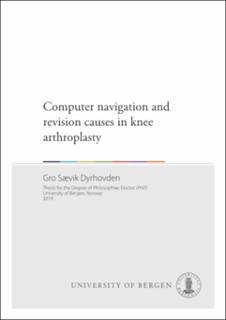| dc.contributor.author | Dyrhovden, Gro Sævik | en_US |
| dc.date.accessioned | 2020-03-10T13:25:41Z | |
| dc.date.available | 2020-03-10T13:25:41Z | |
| dc.date.issued | 2019-12-19 | |
| dc.date.submitted | 2019-11-21T14:05:25.008Z | |
| dc.identifier | container/46/3f/f9/b5/463ff9b5-c5ee-4688-99b3-65b387b08553 | |
| dc.identifier.isbn | 9788230857694 | en_US |
| dc.identifier.isbn | 9788230851531 | en_US |
| dc.identifier.uri | https://hdl.handle.net/1956/21461 | |
| dc.description.abstract | Introduction: There is an increasing demand for total knee arthroplasty (TKA) and unicompartmental knee arthroplasty (UKA), and there is also an increasing number of revisions. To increase quality and patient satisfaction, new implants and techniques are developed. Computer assisted surgery (CAS) was introduced to TKA to improve implant position and alignment of the leg, which theoretically improves knee function and implant survival. The objective of this thesis was to compare CAS to conventional knee arthroplasty (CON) in implant survival, radiological and patientreported outcomes (PROs). It also analyzes time trends in implant survival and revision causes for TKA and UKA, to evaluate the success of previous developments and to assess the need for further improvement. Methods: The thesis is based on two registry studies and one follow-up study from a randomized controlled trial (RCT). Paper I used the Norwegian Arthroplasty Register (NAR) to compare CAS and CON in TKA with respect to implant survival, relative risk of revision and revision causes at up to 8 years of follow-up. In paper II, two 11-year periods of TKAs and UKAs (period 1: 1994-2004; period 2: 2005-2015) from the NAR were compared regarding survivorship and risk of revision due to different revision causes in the latest time period relative to the first. Paper III is a 5-year follow-up from an RCT with 192 patients undergoing TKA with either CAS or CON. The outcomes were migration of the tibial component measured by radiostereometric analysis (RSA) in addition to radiolucent lines, PROs and the proportion of responders. Results: Paper I showed no significant difference in survival or Cox relative risk of revision (RR) for CAS relative to CON (RR=0.8, CI: 0.7-1.0), but CAS had significantly fewer revisions due to malalignment (RR=0.5, CI: 0.3-0.9). Paper II showed that 10 years implant survival was improved for TKA from 91% in period 1 to 94% in period 2 (p<0.001), and there was an increasing risk of early revisions for infection. For UKA, 10 years survival was 80% in period 1 and 81% in period 2 (p=0.3), and the risk of revision caused by progression of osteoarthritis was increased. In paper III, CAS and CON did not differ in implant migration or the occurrence of radiolucent lines. Patients operated with CAS and CON had similar improvement in PROs from preoperative to 5 years. The CAS group had significantly more patients with a high improvement in pain scores (p=0.04). Conclusions: The last two decades, implant survival has improved for TKA, but not for UKA. Patients operated with CAS and CON had similar migration of the tibial component, but CAS had better pain relief 5 years postoperatively. There was no statistically significant difference in survival for CAS compared to CON at 8 years. | en_US |
| dc.language.iso | eng | eng |
| dc.publisher | The University of Bergen | eng |
| dc.relation.haspart | Paper I: Dyrhovden GS, Fenstad AM, Furnes O, Gøthesen Ø. Survivorship and relative risk of revision in computer-navigated versus conventional total knee replacement at 8-year follow-up. Acta Orthop 2016; 87(6): 592-599. The article is available in the main thesis. The article is also available at: <a href="https://doi.org/10.1080/17453674.2016.1244884" target="blank">https://doi.org/10.1080/17453674.2016.1244884</a> | en_US |
| dc.relation.haspart | Paper II: Dyrhovden GS, Lygre SHL, Badawy M, Gøthesen Ø, Furnes O. Have the Causes of Revision for Total and Unicompartmental Knee Arthroplasties Changed During the Past Two Decades? Clin Orthop Relat Res 2017; 475(7): 1874-1886. The article is not available in BORA due to publisher restrictions. The published version is available at: <a href="https://doi.org/10.1007/s11999-017-5316-7" target="blank">https://doi.org/10.1007/s11999-017-5316-7</a> | en_US |
| dc.relation.haspart | Paper III: Dyrhovden GS, Furnes O, Petursson G, Fenstad AM, Lygre SHL, Nilsson KG, Haugan K, Hallan G, Gøthesen Ø. Radiostereometric analysis and patient-reported outcomes for computer assisted and conventional total knee arthroplasty – 5 years follow-up from a randomized trial. The article is not available in BORA. | en_US |
| dc.rights | In copyright | eng |
| dc.rights.uri | http://rightsstatements.org/page/InC/1.0/ | eng |
| dc.title | Computer navigation and revision causes in knee arthroplasty | en_US |
| dc.type | Doctoral thesis | |
| dc.date.updated | 2019-11-21T14:05:25.008Z | |
| dc.rights.holder | Copyright the Author. All rights reserved | |
| dc.contributor.orcid | https://orcid.org/0000-0001-7208-0693 | |
| fs.unitcode | 13-24-0 | |
